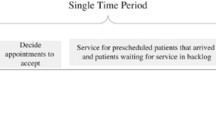Abstract
Appointments in primary care are of two types: 1) prescheduled appointments, which are booked in advance of a given workday; and 2) same-day appointments, which are booked as calls come during the workday. The challenge for practices is to provide preferred time slots for prescheduled appointments and yet see as many same-day patients as possible during regular work hours. It is also important, to the extent possible, to match same-day patients with their own providers (so as to maximize continuity of care). In this paper, we present a mathematical framework (a stochastic dynamic program) for same-day patient allocation in multi-physician practices in which calls for same-day appointments come in dynamically over a workday. Allocation decisions have to be made in the presence of prescheduled appointments and without complete demand information. The objective is to maximize a weighted measure that includes the number of same-day patients seen during regular work hours as well as the continuity provided to these patients. Our experimental design is motivated by empirical data we collected at a 3-provider family medicine practice in Massachusetts. Our results show that the location of prescheduled appointments – i.e. where in the day these appointments are booked – has a significant impact on the number of same-day patients a practice can see during regular work hours, as well as the continuity the practice is able to provide. We find that a 2-Blocks policy which books prescheduled appointments in two clusters – early morning and early afternoon – works very well. We also provide a simple, easily implementable policy for schedulers to assign incoming same-day requests to appointment slots. Our results show that this policy provides near-optimal same-day assignments in a variety of settings.








Similar content being viewed by others
References
Balasubramanian H, Banerjee R, Denton B, Naessens J, Wood D, Stahl J (2010) Improving clinical access and continuity using physician panel redesign. J Gen Intern Med 25(10):1109–15
Balasubramanian H, Muriel A, Wang L, (2011) The impact of flexibility and capacity allocation on the performance of primary care practices, online at the Flexible Services and Manufacturing Journal.
Bodenheimer T, Pham H (2010) Primary care: current problems and proposed solutions. Health Aff 29(5):799–805
Chakraborty S, Muthuraman K, Lawley M (2010) Sequential clinical scheduling with patient no-shows and general service time distributions. IIE Transactions 42(5):354–366
Green LV, Savin S (2008) Reducing delays for medical appointments: a queueing approach. Oper Res 56(6):1526–1538
Green LV, Savin S, Murray M (2007) Providing timely access to care: what is the right patient panel size? Jt Comm J Qual Patient Saf 33:211–218
Gupta D, Potthoff S, Blowers D, Corlett J (2006) Performance metrics for advanced access. J Healthc Manag 51(4):246–259
Gupta D, Wang L (2008) Revenue management for a primary-care clinic in the presence of patient choice. Oper Res 56(3):576–592
LaGanga L, Lawrence S (2007) 2007, Clinic overbooking to improve patient access and increase provider productivity. Decision Sciences 38:2
Liu N, Ziya S, Kulkarni V (2010) Dynamic scheduling of outpatient appointments under patient no-shows and cancellations. Manuf Serv Oper Manag 12(2):347–365
Murray M, Berwick DM (2003) Advanced access: reducing waiting and delays in primary care. J Am Med Assoc 289(8):1035–1040
Muthuraman K, Lawley M (2008) Stochastic overbooking model for outpatient clinical scheduling with no shows. IIE Transactions 40(9):2008
Ozen A, Balasubramanian H (2012) The impact of case mix on timely access to appointments in a primary care group practice. Health Care Manag Sci. doi:10.1007/s10729-012-9214-y
Qu X, Rardin R, Williams JAS, Willis D (2007) Matching daily healthcare provider capacity to demand in advanced access scheduling systems. Eur J Oper Res 183(2):812–826
Robinson L, Chen R (2010) A comparison of traditional and open access policies for appointment scheduling. Manuf Serv Oper Manag 12(2):330–347
Wang W, Gupta D (2011) Adaptive appointment systems with patient preferences. Manuf Serv Oper Manag 13(3):373–389
Kopach R, DeLaurentis P, Lawley M, Muthuraman K, Ozsen L, Rardin R, Wan H, Intrevado P, Qu X, Willis D (2007) Effects of clinical characteristics on successful open access scheduling. Health Care Manag Sci 10(2):111–124
Acknowledgments
This work was funded in part by from the National Science Foundation (NSF CMMI 1031550). Any opinions, findings, and conclusions or recommendations expressed in this material are those of the authors and do not necessarily reflect the views of the National Science Foundation.
Author information
Authors and Affiliations
Corresponding author
Rights and permissions
About this article
Cite this article
Balasubramanian, H., Biehl, S., Dai, L. et al. Dynamic allocation of same-day requests in multi-physician primary care practices in the presence of prescheduled appointments. Health Care Manag Sci 17, 31–48 (2014). https://doi.org/10.1007/s10729-013-9242-2
Received:
Accepted:
Published:
Issue Date:
DOI: https://doi.org/10.1007/s10729-013-9242-2




